Research & Evaluation

NDRI-USA values the importance of research and evaluation as a way to inform program delivery and implementation. A systematic understanding of the processes and/or outcomes of a program can further its development and help to ensure that patients and clients receive the highest quality of care possible.
NDRI-USA staff has expertise with evaluation design, quantitative and qualitative methodologies, and data analysis for the purpose of summarizing findings. NDRI-USA trainings are then designed to promote the use of evidence-based and promising “best practices” in the service field by translating research and evaluation findings into practical and accessible guidelines for immediate programmatic application.
Center for Excellence in Integrated Care
Funder: New York State Health FoundationGrantee: NDRI-USA
Project Abstract: Through the New York State Health Foundation’s Center for Excellence in Integrated Care (CEIC), NDRI-USA staff worked directly (i.e. on site) with 603 licensed outpatient mental health (Office of Mental Health [OMH]) and substance abuse (Office of Alcoholism and Substance Abuse Services [OASAS]) treatment programs in New York State to foster the integration of substance abuse and mental health services. An evaluation of this initiative, funded by the NYSHF and conducted by NDRI-USA, examined the impact of CEIC’s approach to technical assistance on integrated care capacity. Three publications listed below outline findings from this evaluation. Paper 1 describes integrated COD capacity in the first 447 outpatient mental health and substance abuse clinics that were assessed. Paper 2 describes gains in integrated COD capacity at follow-up (approximately 18 months post baseline) for 150 randomly selected programs. Paper 3 examines the relationship between integrated COD capacity and client retention in treatment in 185 outpatient programs.
Downloads: CEIC Final Report
Publications:
Sacks, S. Chaple, M. Sirkantraporn, J., Sacks, J.Y., Knickman, J. & Martinez, J. (2013). Improving the Capability to provide integrated mental health and substance abuse services in a state system of outpatient care. Journal of Substance Abuse Treatment, 44(5): 288-93.
- Article Abstract: The paper reports on the capability of New York State (NYS) outpatient programs to provide
integrated services for co-occurring disorders (COD). Assessments of 447 outpatient clinics, using two dual
diagnosis capability indices (one used in addiction settings, the other in mental health settings), produced an
overall score of 2.70, interpreted to position NYS clinics closer to "capable" (3.0 = Dual Diagnosis Capable)
than to "basic" (1.0 = Alcohol [Mental Health] Only Services). "Assessment" and "Staffing" received the highest
scores; i.e., clients with COD were usually identified, and staff (with some additional training and supervision)
could treat both disorders effectively. While programs were generally prepared for clients with COD (e.g.,
welcoming such clients into the program, employing staff with competencies in both disorders, and having
established routine screening and assessment to identify COD), results showed that the actual delivery of
effective treatment was less satisfactory. The project demonstrated that COD capability can be assessed
system-wide, using direct observation. http://www.ncbi.nlm.nih.gov/pubmed/23317513
- Article Abstract: This study assessed gains that New York State mental health and addiction outpatient clinics
achieved in their capacity to provide integrated mental health and substance abuse services for persons with
co-occurring disorders. The investigators used two Dual Diagnosis Capability (DDC) indices-one for Addiction
Treatment (DDCAT) and one for Mental Health Treatment (DDCMHT)-to measure integration capability at
baseline (n = 603) and at follow-up (n = 150), an average of 2 years post-baseline, during which time
programs received technical assistance and implementation support. At baseline, the average program score
was 2.68, below the "Capable" level (3.0 on a 5-point scale). At follow-up, the average score was 3.04, and the
percent of programs rated Capable more than doubled (from 22 to 52%). Programs with lower baseline
scores and those with more time to follow-up (2-3 years) had the greatest increases, but 12 to 18 months
were sufficient to realize sizeable and significant improvements. http://www.ncbi.nlm.nih.gov/pubmed/24928534
- Article Abstract: Objective: The study examined the degree to which licensed outpatient substance abuse
treatment programs were capable of delivering integrated services for individuals with co-occurring
substance use and psychiatric disorders. Aggregate measures of client retention were also obtained, and their
relationship with capability scores was explored. Methods: The co-occurring or dual diagnosis capability of
each program was measured with the Dual Diagnosis Capability in Addiction Treatment (DDCAT) index, a 35-
item rating tool organized into seven dimensions that categorizes programs along a continuum where 1 =
addiction-only services, 3 = dual diagnosis–capable, and 5 = dual diagnosis–enhanced. Admission and
discharge data were obtained from a state regulatory agency database for clients with co-occurring disorders
who received services from state-licensed outpatient substance abuse clinics and who had been discharged
from treatment over a 6-month period defined as the 3 months before and after the DDCAT assessment.
Admission and discharge data were then aggregated to the program level and their relationship with the
DDCAT data was examined. Results: A total of 185 state-licensed outpatient substance abuse clinics were
included in the analysis. Generalized linear models showed a significant positive relationship between DDCAT
scores and length of stay (odds ratio = 1.209; p < .001), which indicated that clients with co-occurring
disorders stayed longer in treatment programs with higher DDCAT scores. Analyses also demonstrated that
five DDCAT dimensions were significantly related to length of stay (odds ratios ranged from 1.057 to 1.155; p
< .01); the two exceptions were the screening/assessment and treatment dimensions. Conclusions: Given that
prior research established treatment retention as a predictor of long-term outcomes, such as relapse to drug
use, this study represents an important first step toward validating the DDCAT. Further validation of the
DDCAT should consider incorporating a broader range of treatment quality indicators and client outcomes. http://www.tandfonline.com/doi/abs/10.1080/15504263.2013.779128#preview
Center for Drug Use and HIV Research
Funder: National Institute on Drug Abuse (NIDA)Grantee: NDRI-USA through a subcontract with New York University
Project Abstract: CDUHR, funded by the National Institute on Drug Abuse, is the first center for the socio-behavioral study of substance use and HIV in the United States. The Center is dedicated to increasing the understanding of the substance use-HIV/AIDS epidemic, particularly among individuals in high-risk contexts. The Center's theme is "Discovery to Implementation & Back: Research Translation for the HIV/Substance Use Epidemic." The Center facilitates the development of timely new research efforts, enhances implementation of funded projects and disseminates information to researchers, service providers and policy makers. NDRI-USA’s role with CDUHR was to assist with dissemination efforts, including to: 1) expand the dissemination of CDUHR research findings to a broader audience and broaden the array of topics covered related to HIV, integrating STIs and other infectious diseases; 2) oversee the development and evaluation of new dissemination mechanisms; 3) facilitate partnership and collaboration between CDUHR researchers and service providers at various stages of research projects; and 4) assist CDUHR investigators in the conduct of research through development of curricula and dissemination efforts.
Project Website click here
Fact Sheets (scroll over thumbnails for titles):
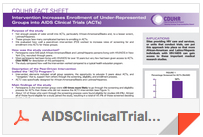

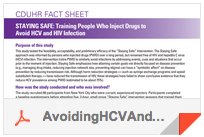



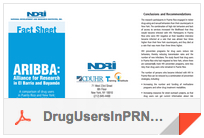
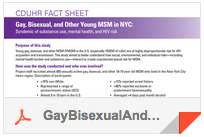
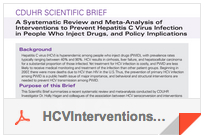
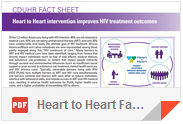
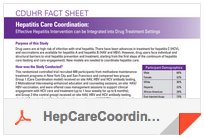
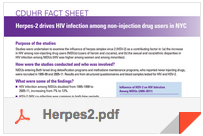
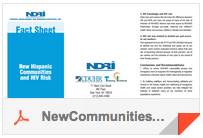
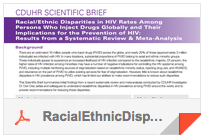
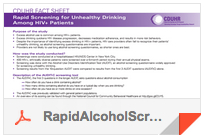
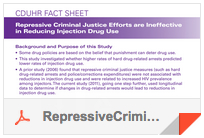
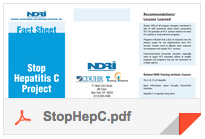
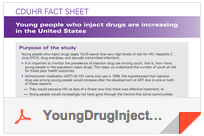
Facilitating Integrated Behavioral Health Services in FQHCs
Funder: The Nicholson FoundationGrantee: National Development & Research Institutes
Project Abstract: In the advent of healthcare reform, it is incumbent upon policy makers, researchers, and clinicians to foster the bi--‐directional integration of behavioral health and medical services. The Nicholson Foundation funded NDRI-USA to conduct “A Pilot Project to Facilitate the Delivery of Integrated Behavioral Health [Substance Use and Mental Health] in Federally Qualified Health Centers (FQHCs)” as part of their larger agenda to achieve integrated care. The overall purpose of this pilot project was to demonstrate the readiness of selected New Jersey FQHCs to integrate behavioral (substance use and mental health) healthcare services in primary care settings (FQHCs), and to obtain data documenting improvements in service integration subsequent to the delivery of technical assistance and implementation support. The approach to technical assistance and implement support consisted of three activities:
- 1. Site Visit Assessment – An independent and objective reviewer used the Dual Diagnosis Capability in Health Care Settings (DDCHCS) index to assess the extent to which each FQHC had integrated behavioral health services. Site visits lasted approximately 6 hours, and were comprised of in-depth staff interviews, program observation, record reviews, and facility tours. At the end of the site visit, the assessor provided preliminary feedback to clinic staff, summarizing key strengths to build on, and identifying immediate opportunities to improve COD capability. Thus, the baseline assessment provided not only a standard measure of COD integration, but also a framework and individual benchmarks for technical assistance;
- a narrative review of the assessor’s observations and recommendations for improving the clinic’s COD capability in each of seven DDCHCS dimensions;
- a score sheet denoting the score received on each of the 35 items, summary scores for each of the seven dimensions, and a total score for all 35 items;
- a line graph of dimension scores, depicting the clinic’s profile such that the provider could readily identify strengths and opportunities for enhancement
2. Assessment Report – Within 10 days, providers received a formal report that included:
3. Implementation Planning and Support – An implementation plan was developed by site staff, with a framework and guidance provided by NDRI-USA staff. The plan proposed at least 5 to 7 key improvements in service delivery to be made during the pilot project. Plans were reviewed on a monthly basis with FQHC staff to ensure that implementation was proceeding according to plan and to provide technical assistance to address barriers.
Physicians Behavioral Health and Addictions Learning Lab (PBHALL)
Funder: The Nicholson FoundationGrantee: NDRI-USA through a subcontract with Oregon Health Sciences University
Project Abstract: Opiate abuse, dependence, and overdose continue to escalate nationwide, with prescription opioid abuse identified as one of the nation’s most significant public health concerns. Despite well-documented clinical evidence and the widespread availability of medications for substance use disorders, adoption of medication assisted treatment (MAT) remains low. In order to respond to the growing opiate crisis in New Jersey with well-established clinical protocols, the Physician Behavioral Health and Addiction Learning Lab (PBHALL) will pair established, expert safety-net primary care providers of buprenorphine with an interested cohort of NJ safety net providers. Through an introductory face-to-face training followed by expert consultation, and twice monthly group case review discussions, this learning collaborative will facilitate access to buprenorphine in primary care for NJ residents.
Process and outcome objectives for this project include: 1) recruitment of 10-12 physicians to participate in the learning collaborative; 2) increases in buprenorphine prescribing (i.e. number of patients and prescriptions) among participating physicians; 3) improved provider attitudes toward and confidence in working with opioid-dependent patients and patients with substance use disorders; 4) engagement of providers in twice monthly learning collaborative calls for technical assistance; 5) identification of factors that facilitate or impede implementation of buprenorphine; and 6) provider satisfaction with PBHALL.
SAT2HIV
Funder: National Institutes on Drug Abuse (NIDA)Grantee: NDRI-USA through a subcontract with RTI
Project Abstract: Although substance use among people living with HIV/AIDS has been associated with increased psychiatric problems, poorer HIV viral suppression, poorer HIV medication adherence, and increased likelihood of engaging in risk behaviors that result in infection transmission to others, integration of substance use and HIV/AIDS services remains limited. The proposed study seeks to address this gap by providing new knowledge regarding the effectiveness of Brief Interventions for substance use within community-based HIV/AIDS service settings, as well as new knowledge regarding how to address the well-documented underutilization of evidence-based practices in real-world settings. The proposed study is a Type 2 Effectiveness-Implementation Hybrid Trial. Aim 1 will experimentally test the effectiveness of a motivational interviewing-based brief intervention for substance use within community-based HIV/AIDS service organizations, relative to usual care. Aim 2 will test the effectiveness of adding an organizational-level implementation intervention called Implementation and Sustainment Facilitation to the implementation strategy currently used by SAMHSA-funded Addiction Technology Transfer Centers (ATTCs).
Evaluation of Brooklyn Treatment Court/Samaritan Village 90-Day Residential Treatment Program
Funder: New York State Unified Court SystemGrantee: NDRI-USA
Project Abstract: Brooklyn Treatment Court (BTC) provides an intensive 90 day residential rehabilitation program with an optional administration of Vivitrol for participants whose primary drug of choice is alcohol or opiates. Participants are referred to this treatment program by the presiding Judge, following consultation with case managers and program staff. BTC subcontracted Samaritan Village to provide treatment services and NDRI-USA has been contracted to provide an evaluation of this program. Evaluation activities include collection and analysis of both quantitative and qualitative data. Quantitative data come from: the BTC database (the Uniform Treatment Assessment, UTA, used by all drug courts in New York State); the Government Performance Reporting Act (GPRA) tool, developed by SAMHSA and required for all SAMHSA-funded projects; and data provided by Samaritan Village. Qualitative Data come from semi-structured interviews conducted with program staff, court staff, and participants. The purpose of this evaluation is to determine what works, what doesn’t work and to use this information to inform program improvements.

